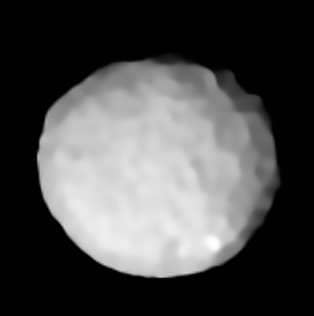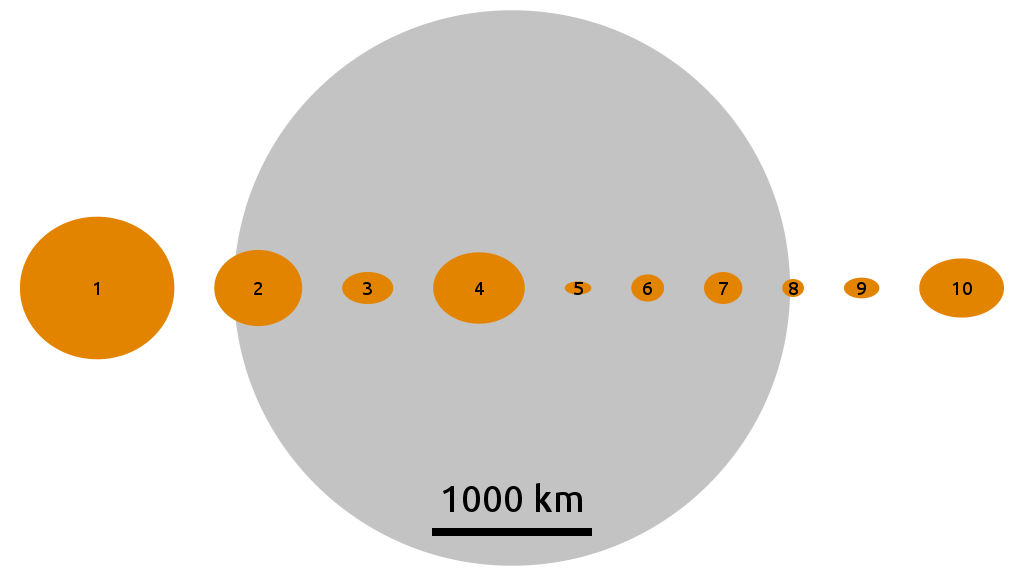2 Pallas is the third largest asteroid in the asteroid belt, with a diameter of around 512 kilometers. Its high inclination, along with its orbit eccentricity, piques astronomers’ interest.
However, it has some characteristics in common with other celestial bodies, including Ceres and Vesta. Studying the nature of 2 Pallas has important implications for our solar system. This subject is fascinating to both amateur and professional astronomers.
What is 2 Pallas
Classification and Characteristics
Pallas is an interesting world, located well within our solar system’s asteroid belt. It is the third-largest asteroid, slightly smaller than Vesta, with a diameter of about 512 km. Its size and structure suggest it is not just a regular asteroid but likely a remnant protoplanet. This means it could have been on its way to becoming a planet if conditions had been different.
The asteroid spins relatively fast on its axis, with a rotation period of about 7.81 hours. What’s interesting about 2 Pallas is its orbit. Unlike most asteroids in the belt, it has a highly inclined and eccentric orbit. This strange path doesn’t simply go around the Sun in a flat plane like Earth does. Instead, it takes a more tilted and stretched route.
It completes an orbit around the Sun every 4.611 Earth years, a journey influenced by its near-18:7 resonance and approximate 5:2 resonance with Jupiter. These relationships with Jupiter pull on it gravitationally and influence its orbit over extended time. The composition of 2 Pallas adds another layer to its uniqueness. Its surface is predominantly silicate, with little iron and water.
This gives hints at how it formed and what materials were available in the early solar system. At least 9% of its surface has craters larger than 40 km. This reveals a fascinating history of cosmic collisions.
Discovery and Historical Context
2 Pallas holds a very special place in astronomical history. It was the second asteroid discovered, coming in right after Ceres. On March 28, 1802, German astronomer Heinrich Wilhelm Olbers made a significant discovery. This moment struck a key change in how we viewed the small bodies of the solar system. That discovery filled a long-standing gap between Mars and Jupiter. For centuries, astronomers had wondered about this vacuous space.
The finding of 2 Pallas has greatly enhanced our knowledge of the asteroid belt. Its follow-up study has illuminated the early solar system. It acts like a window into the past, telling us important details of the conditions and processes involved in the formation of our solar system.


Physical and Orbital Features
Surface and Composition
Pallas mostly contains silicate materials with little iron or water when compared with the spectroscopic observations. That gives us clues about the conditions in the early solar system in which it formed.
Pallas’s shape tells a story too. It goes way out of its equilibrium shape, and as a result, it hasn’t yet reached the rounded shape that’s common among dwarf planets. Its non-spherical shape comes from its current rotation period and mass distribution. This unusual form gives us a glimpse of its dynamic history.
Orbital Dynamics and Path
Now, let’s talk about Pallas’s journey through space. Its orbit is quite the spectacle. With an orbital inclination of 34.8°, Pallas takes a steep path through the asteroid belt, making its presence unique among its peers.
The high inclination suggests a dynamic past, possibly involving gravitational interactions that knocked it into its current path. Pallas completes one orbit around the Sun in about 4.611 Earth years, which is relatively quick in astronomical terms.
Its axial tilt is another fascinating feature; at 84°, it’s almost on its side! This tilt means one of its poles is nearly pointed directly at the Sun during its orbit, creating extreme seasonal variations. With a rotation period of 7.8132 hours, Pallas spins rapidly, providing a short day-night cycle.
Despite its speed, its mean opposition magnitude of +8.0 makes it visible with 10×50 binoculars, a treat for amateur astronomers.
Accessibility and Exploration
Observation Techniques
When you’re talking about observing 2 Pallas, it’s a matter of using the right tools and techniques. This asteroid, which loiters between Mars and Jupiter, is a tough cookie to crack. Why? It’s not a Near Earth Object, so it is always a safe distance from us.
For example, the Hubble Space Telescope has provided close-up views of Pallas. By examining how light reflects off the asteroid, scientists can determine its surface characteristics and chemical makeup.
Space Missions and Studies
Now when it comes to space missions, 2 Pallas isn’t exactly at the top of the list. NASA doesn’t view it as a destination for human exploration. Why? It’s just too far.
We don’t have any missions pointed directly at Pallas. That doesn’t mean scientists aren’t interested. They use data from missions like Dawn and other asteroid explorers to compare and learn more about Pallas. These missions help us understand more about the asteroid belt and how Pallas fits into that puzzle.
Comparison with Similar Objects


Looking at 2 Pallas, we find curious similarities and differences. It really jumps out when we compare it to other things in our own solar system, specifically Ceres and Vesta. These three are some of the largest bodies in the asteroid belt, so it’s only natural to compare them.
Pallas is another massive asteroid, like Ceres and Vesta. Its diameter is about 512 km, which is roughly 15 percent of the moon’s diameter. This size puts Pallas just a little smaller than Vesta, which is measured to be about 525.4 km. All three bodies have a similar composition, consisting mainly of rock and metal — the kind of material you’d typically expect to find on a large asteroid.
One must observe the orbital patterns of these celestial bodies. Pallas exhibits a near-1:1 orbital resonance with Ceres. This means their orbits are synchronized in such a way that their gravitational interactions, while coincidental, create a stable balance. You can also observe this phenomenon on other celestial bodies. For instance, the moons of Jupiter have similar patterns in their orbital space.
Pallas has a mass 79% that of Vesta. It also contains 22% of Ceres’s mass and just a quarter of a percent of the Moon’s mass. This makes it a major presence in the asteroid belt—but not the biggest.
Conclusion
Exploring 2 Pallas opens doors to new worlds. It looms even larger than the asteroids around it, and it’s teaching us things about our solar system. Its unique features make it a gem for astronomers and space fans alike. The peculiar orbit of Pallas intrigues scientists and can shed light on asteroid dynamics. Its sheer size and composition have fascinated those who wonder about space beyond our reach.
Frequently Asked Questions
What is 2 Pallas?
Pallas is the third-largest asteroid in the asteroid belt. It was discovered in 1802. Named after the goddess Pallas Athena, it is a significant object in the study of the solar system.
What are the physical features of 2 Pallas?
Pallas is not spherical in shape, having a diameter of approximately 512 kilometers. Its surface is rocky, and it reflects light relatively well. It is one of the largest asteroids, which makes it an interesting subject for astronomers.
How does 2 Pallas orbit the Sun?
Pallas travels around the Sun in an ellipse. Its orbit is tilted, meaning it moves at an angle compared to most solar system objects. This strange orbit makes it very interesting for orbital studies.
What are some notable facts about 2 Pallas?
Pallas was the second asteroid ever discovered. It plays an important role in understanding the composition of the early solar system. Its size and orbit make it a significant object for scientific study.
How accessible is 2 Pallas for exploration?
Pallas is difficult to study because of its distance and its inclination of orbit. No missions have yet focused on it; future missions to space could investigate it as technology becomes more advanced.
How does 2 Pallas compare with similar objects?
Asteroid 2 Pallas is similar in size to Vesta and a bit smaller than Ceres. Its unusual orbit and what it’s made of make it special. It’s tipped more than most large asteroids, presenting a unique research opportunity.
Why is studying 2 Pallas important?
Studying 2 Pallas helps scientists understand asteroid composition and solar history. Its distinctive features provide clues about planetary formation and potential resources for future exploration.